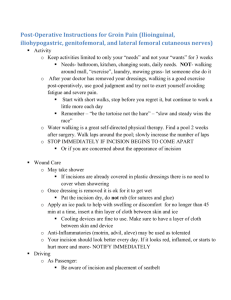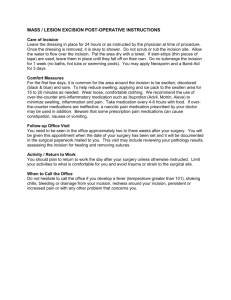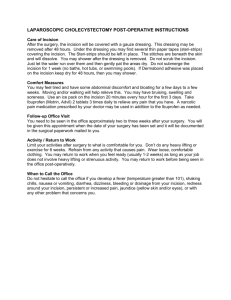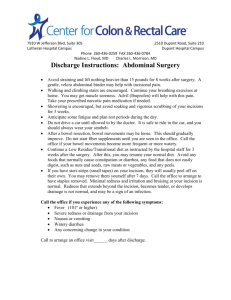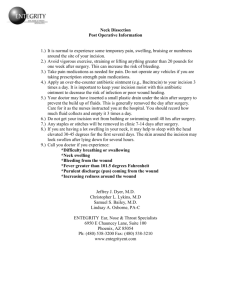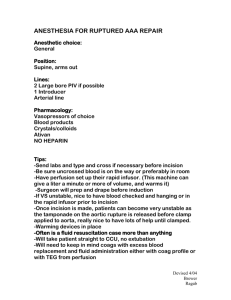Thyroidectomy Postoperative Instructions
advertisement
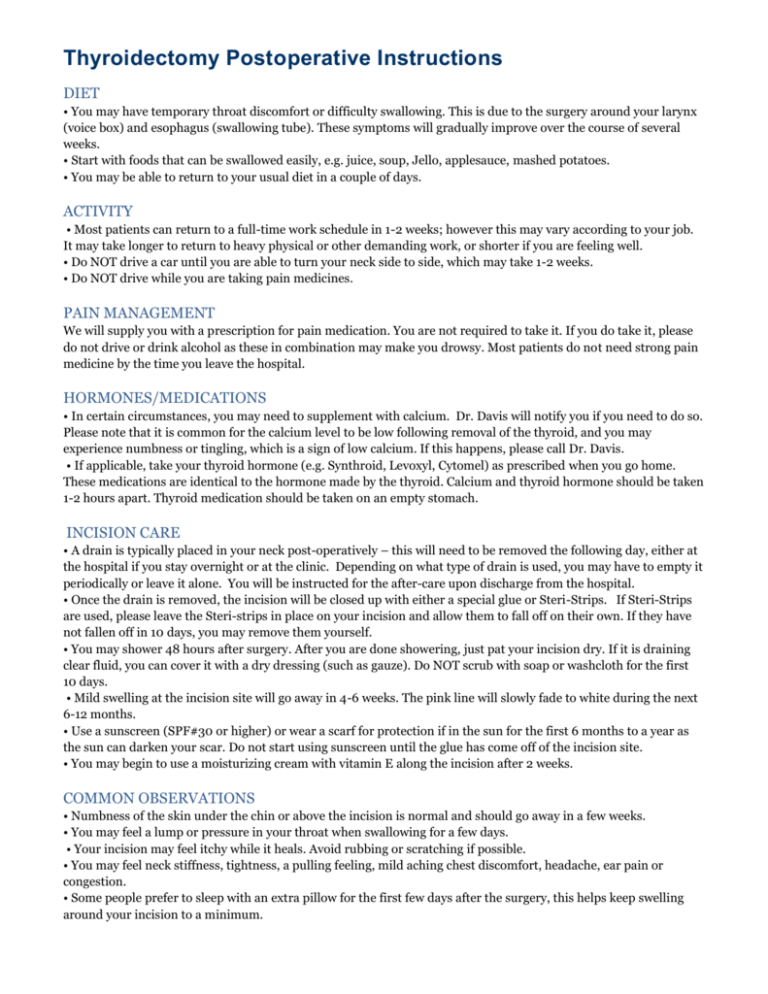
Thyroidectomy Postoperative Instructions DIET • You may have temporary throat discomfort or difficulty swallowing. This is due to the surgery around your larynx (voice box) and esophagus (swallowing tube). These symptoms will gradually improve over the course of several weeks. • Start with foods that can be swallowed easily, e.g. juice, soup, Jello, applesauce, mashed potatoes. • You may be able to return to your usual diet in a couple of days. ACTIVITY • Most patients can return to a full-time work schedule in 1-2 weeks; however this may vary according to your job. It may take longer to return to heavy physical or other demanding work, or shorter if you are feeling well. • Do NOT drive a car until you are able to turn your neck side to side, which may take 1-2 weeks. • Do NOT drive while you are taking pain medicines. PAIN MANAGEMENT We will supply you with a prescription for pain medication. You are not required to take it. If you do take it, please do not drive or drink alcohol as these in combination may make you drowsy. Most patients do not need strong pain medicine by the time you leave the hospital. HORMONES/MEDICATIONS • In certain circumstances, you may need to supplement with calcium. Dr. Davis will notify you if you need to do so. Please note that it is common for the calcium level to be low following removal of the thyroid, and you may experience numbness or tingling, which is a sign of low calcium. If this happens, please call Dr. Davis. • If applicable, take your thyroid hormone (e.g. Synthroid, Levoxyl, Cytomel) as prescribed when you go home. These medications are identical to the hormone made by the thyroid. Calcium and thyroid hormone should be taken 1-2 hours apart. Thyroid medication should be taken on an empty stomach. INCISION CARE • A drain is typically placed in your neck post-operatively – this will need to be removed the following day, either at the hospital if you stay overnight or at the clinic. Depending on what type of drain is used, you may have to empty it periodically or leave it alone. You will be instructed for the after-care upon discharge from the hospital. • Once the drain is removed, the incision will be closed up with either a special glue or Steri-Strips. If Steri-Strips are used, please leave the Steri-strips in place on your incision and allow them to fall off on their own. If they have not fallen off in 10 days, you may remove them yourself. • You may shower 48 hours after surgery. After you are done showering, just pat your incision dry. If it is draining clear fluid, you can cover it with a dry dressing (such as gauze). Do NOT scrub with soap or washcloth for the first 10 days. • Mild swelling at the incision site will go away in 4-6 weeks. The pink line will slowly fade to white during the next 6-12 months. • Use a sunscreen (SPF#30 or higher) or wear a scarf for protection if in the sun for the first 6 months to a year as the sun can darken your scar. Do not start using sunscreen until the glue has come off of the incision site. • You may begin to use a moisturizing cream with vitamin E along the incision after 2 weeks. COMMON OBSERVATIONS • Numbness of the skin under the chin or above the incision is normal and should go away in a few weeks. • You may feel a lump or pressure in your throat when swallowing for a few days. • Your incision may feel itchy while it heals. Avoid rubbing or scratching if possible. • You may feel neck stiffness, tightness, a pulling feeling, mild aching chest discomfort, headache, ear pain or congestion. • Some people prefer to sleep with an extra pillow for the first few days after the surgery, this helps keep swelling around your incision to a minimum. • Your voice may be hoarse or weak. Pitch or tone may change. You may have difficulty singing. This usually returns to normal over 6 weeks to 6 months. • You do not need to be in bed. Being active is normally well tolerated within reason. • If you are taking supplemental calcium or narcotics, you may also want to take a stool softener, such as over-thecounter Colace or Senna, to avoid constipation. Stay hydrated by drinking some extra water. FOLLOW-UP • If a drain is placed in your neck post-operatively, a follow-up visit the following day (either at the hospital if you stay the night or the following day at clinic) will be necessary to have the drain removed. • If no drain is placed, a follow-up visit 1 week post-operatively is necessary for a wound check. WHEN TO CALL YOUR DOCTOR • Call your doctor or go to the Emergency Room if you have a fever (temperature greater than 100.5), chills, lightheadedness, shortness of breath, difficulty breathing, nausea, vomiting, numbness or tingling in your fingers, hands, or mouth, muscle spasms, or if you notice signs of wound infection (redness, tenderness, or drainage from the incision). Please also call or go to the Emergency Room if you have any other urgent concerns. Office Phone: 310.372.0700 For any questions or problems, please call the office. For after-hours and weekends, one of Dr. Davis’ colleagues may be on call and can help you.

